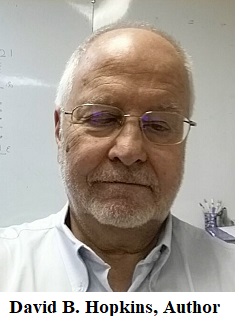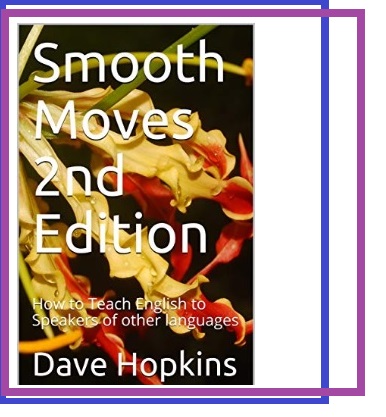
Winter 2018
Blues Farley,
Our Family
Friend
Mono No
Aware, All
Things Must
Pass
Second Edition,
Better Than
the First
Interview
with Robb
Scott, Editor
and Founder
![]()
/Index/
/Letters/
/Profiles/
/Search/
/Podcasts/
![]()
Subscribe
for free!

Second Edition of Classic Teaching Guide
New Dave Hopkins Text Announced
Dave Hopkins has released the new 2nd edition of "Smooth Moves," his master stroke of a guidebook for new, prospective, and veteran teachers on how to teach English to speakers of other languages. He has teamed with Valentina Serbinova, who holds a master's degree in linguistics as well as the CELTA teacher training certificate, considered the gold standard and provided by Cambridge English Language Assessment, and together they have produced a stronger, more tightly presented compendium of solid ideas and techniques to assist English teachers in understanding and answering the decisions facing them in any classroom setting.
At the outset, I must stipulate for the reader that it is nearly impossible for me to avoid expressing enthusiasm for a book from a mentor and friend I have known since we first met in the Tokyo offices of the University of Nevada-Reno's intensive English program in 1989, when we were both teaching ESL and college prep to recent Japanese high school graduates.
To be completely honest, I must further stipulate that it would be tough for me to find anything wrong with the work product of the man who became my boss in 1990, when I was hired as a lecturer in the Ohio Program for English Language Teaching (OPELT), a curriculum design team within Chubu University, Kasugai, Japan. Yet, his leadership style always has been to encourage those of us around him to be objective and straightforward in expressing our views, and I can remember Dave being very open to ideas that meant going in new directions if supported by data and reason.
It is also my obligation to confess that for six months in Riyadh, Saudi Arabia, in early 2012, I had wonderful daily conversations about teaching and language learning with my good friend Dave over our morning lattes, at King Saud University, where I was a special education researcher and he was a teacher trainer. I don't know how I can promise the reader will receive an unbiased account of my examination of the new and improved second edition when the first edition was my primary guide in the work I did adapting ESL/EFL curriculum for students with visual impairments at King Saud University those six months.
Given these limitations, I will strive to present a balanced and useful review of the new version of "Smooth Moves," authored by Dave and nicely edited by Valentina Serbinova.
What stands out to me is that it is much easier now to access information in this second edition. Dave Hopkins is a unique thinker in the field of TESOL, language learning, and cross-cultural communication. I would say that only Diane Larsen-Freeman and the late Tracy Terrell bear any real resemblance to Dave Hopkins and his approach to teaching and learning. He started at Marlboro College (B.A. in Russian Studies) and the School for International Training (Masters in Intercultural Management and Master of Arts in Teaching ESOL), in the late sixties and early seventies, followed by stints directing Peace Corps and refugee projects in the late seventies and early eighties, and he has never stopped actively teaching over the nearly five decades his career has spanned since then.
By actively teaching, I mean Dave is in the classroom actually as well as figuratively continuously. And by this I mean to say that he is continually evaluating and re-evaluating himself, his students, their learning, and his own conceptions of what is really going on in actual classrooms as well as in classroom settings and class routines and lessons that he works through in his mind and in conversations with lucky friends, colleagues, and trainees.
"Smooth Moves" is not a book of recipes and it is not intended to persuade the reader to agree with Dave's present philosophy of learning. He is sincerely interested in making his own teaching as transparent a model as possible for anyone (including himself) to learn from and improve on. After 50 years of teaching, Dave Hopkins still does not believe it is professional or ethical for any teacher to walk into class without having written down and run through in their minds a plan, even if as he reminds the reader, things are going to happen in real time with your actual students that can prompt and justify making changes while implementing your plan.
Dave has a specific idea of what needs to be included in every lesson plan (which he makes sure to remind the reader is often going to be spread over more than a single class period). The six parts of the Dave Hopkins lesson are: 1) a warmer "to get students comfortable and lead into the target language of the lesson; 2) context and modeling to "demonstrate meaning through pictures, actions, examples, and writing"; 3) controlled practice to "initiate speaking practice"; 4) vocabulary and lexis explanation to "expand the vocabulary options"; 5) listening/reading to "provide listening and reading activities focused on the target language in context and cotext"; and 6) communicative activity to "implement opportunities for learners to apply the target language for their own purposes."
"Smooth Moves" is all about the decisions facing a teacher in preparing for each of these six stages. You are not going to find a magic technique or activity that always works for you with every group of students, according to Professor Hopkins. Instead, he explains the different aspects of the classroom learning situation that a teacher needs to be aware of in order to understand what is and isn't working and to find out what your students need (and want).
It is clear to me--partially from having worked with Dave Hopkins in school settings on three different occasions in my life--that he takes nothing for granted and makes few if any assumptions. In addition, along the way in his 50 years of teaching students and training teachers and running programs, he has accumulated LOTS of sharp, doable, sensible activities that he himself has seen in action. That does not mean all of them will work for you, but many of them will do the job quite well in most cases you encounter.
As a colleague and fellow teacher "down the hall" from me in Tokyo, and as my boss in Kasugai, and as an early morning conversationalist in Riyadh, there are several things about Dave Hopkins that shine through and are demonstrated in the way he has presented his ideas and suggestions in this book. First, he is not the "know it all" person who has the answer and wants to find and solve all your problems for you. He is too busy himself questioning his own latest hypotheses about what works--on a global and on a local scale. And he is always up for a good conversation where you challenge his thinking and he challenges your thinking because both of you want to improve your teaching and your understanding of teaching.
I believe that carrying Dave's hard copy or kindle-version book with you on the job wherever you find yourself is going to be like having one more great friend and confidant to be there with you and remind you that you are not facing your challenges alone.
He's been a good friend to me. Yesterday we started chatting about language learning and I found myself thinking about things I hadn't thought about in years even though they are among my favorite issues, in this case about how words convey meaning.
Thanks for setting the bar high Dave Hopkins and Valentina Serbinova! Much appreciated.
2016 ESL MiniConference Online


By Robb Scott
DrRobbScott@gmail.com
